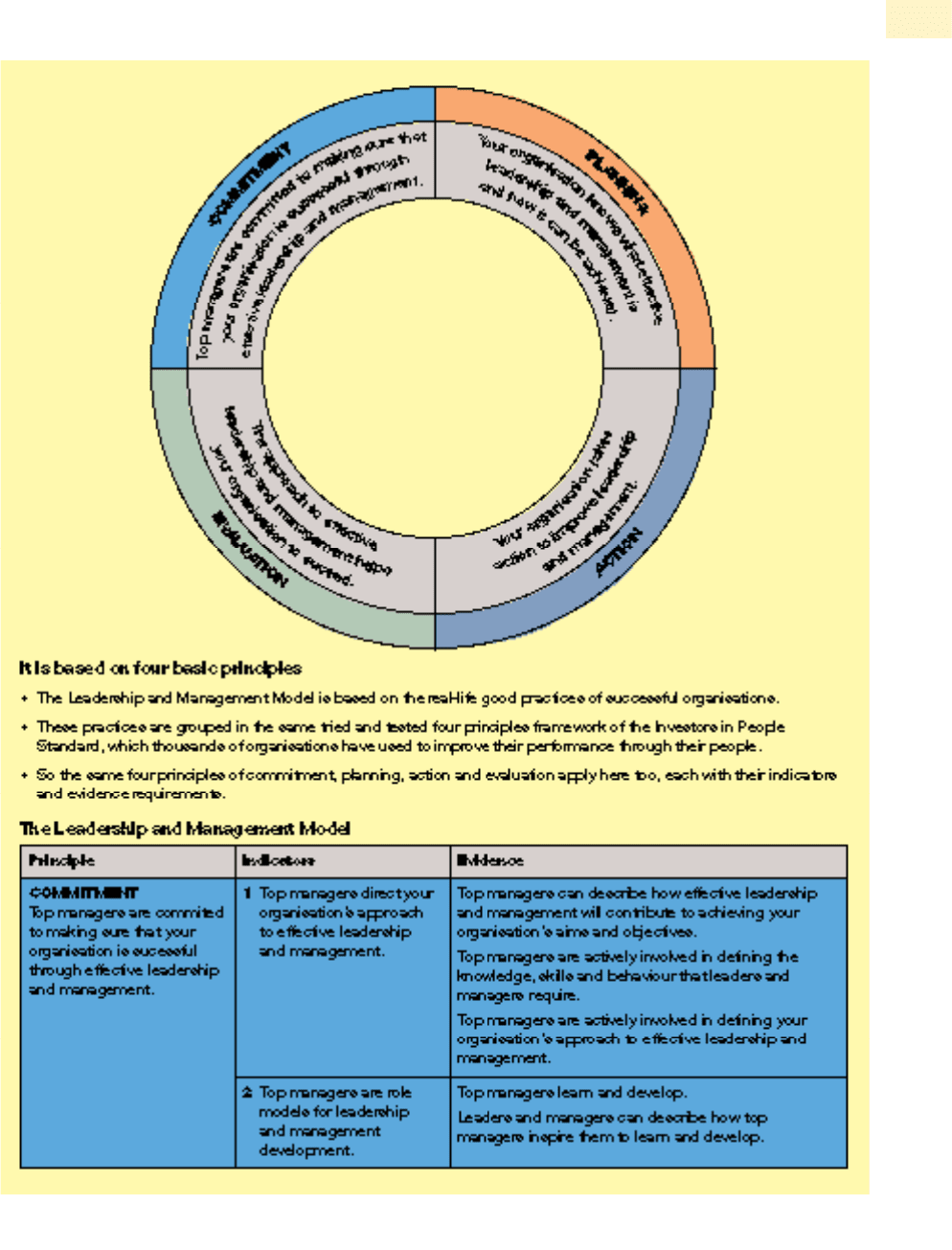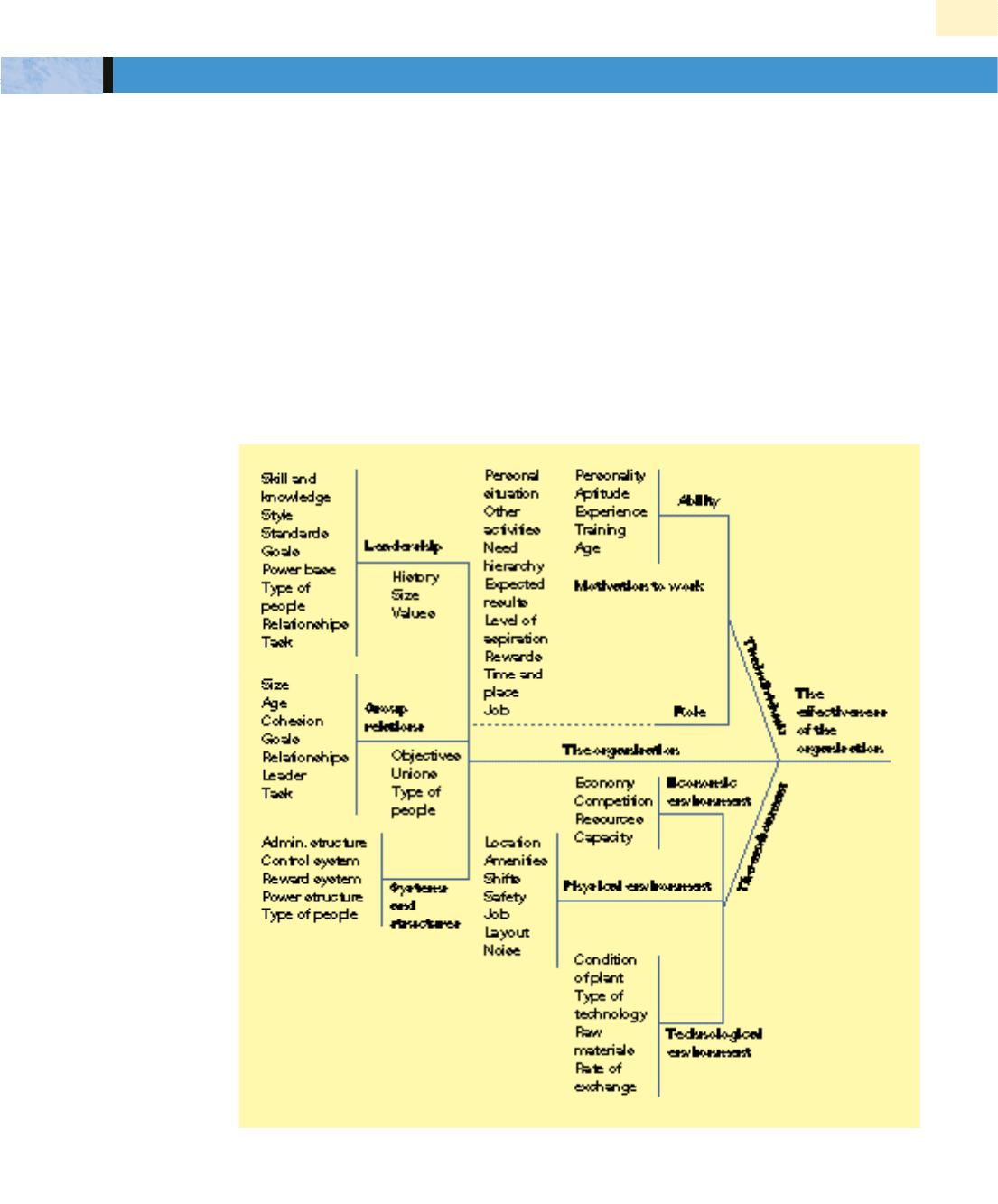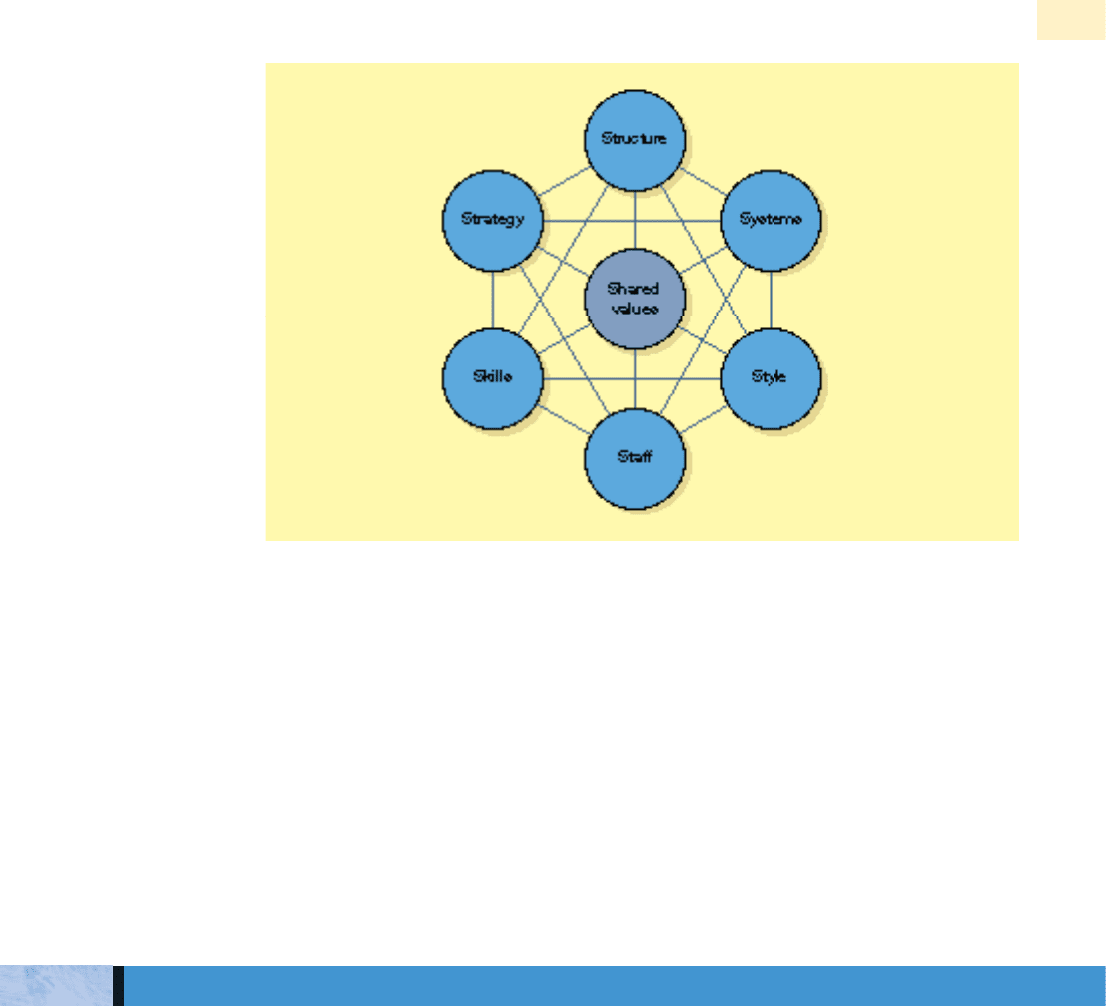Mullins L.J. Management and organisational behaviour, Seventh edition
Подождите немного. Документ загружается.


competitors. The reports note the need for managers with an appropriate knowledge of
languages, cultures and business environments of our trading partners.
The Open University Business School and the (then) Institute of Management
undertook a research project to evaluate the state of management development in
British organisations, and to link back to the 1987 Constable and McCormick survey.
43
Findings of the portrait indicate that most organisations see management development
as having a substantial impact on their organisations and that managers say they want
more development. Main conclusions from the study include the following.
■ The report is more upbeat about the present and future management development.
Much has changed for the better in the past 10 years with the promise of more to
come.
■ Respondents were generally satisfied that management development was achieving
its objectives and having a significant impact on the organisation.
■ Organisations do not appear to have neglected responsibilities for management
development but the majority do not have a policy statement nor a specific budget
for management development.
■ The rate of change should accelerate and provide a rationale for organisations to see
development as a necessary, not an optional, response.
An account of a review of management structure and a competencies pro-
gramme approach to management development at Costa Coffee is given in
Management in Action 23.2.
Improvement in organisational performance
A recent survey of European managers carried out by the European Commission,
Leonardo da Vinci CVTS programme and the DTI has found that investment in man-
agement training and development can and does improve organisational performance.
The survey canvassed the views of 1400 HR managers in 700 private sector organisa-
tions across seven European countries. The findings indicate that it is not enough just
to have ‘best practices’. Managers development can make a substantial impact on firm
performance but it needs to be linked to the business strategy. It is also important that
line managers perceive their top team seeing this as a genuine and sustained commit-
ment, and to be delivering on the promise of management development. Across
Europe, an average of nine days per manager is given to training but with wide varia-
tions in the amount spent per head. Cost and practical difficulties of covering for staff
were generally more a reason for constraints in development than lack of support from
the top team or lack of enthusiasm from managers themselves.
44
The Constable/McCormick Report and the Handy Report were instrumental in the cre-
ation of the Management Charter Initiative (MCI) in 1988. The MCI is an independent
body set up by employers and backed by the government with the aim of improving
the performance of the UK’s managers. It is the operating arm of the National Forum
for Management Education & Development and supported by the Department for
Education and Skills. MCI has championed the competence-based approach to man-
agement development with emphasis on whether managers can actually do their jobs.
MCI has two roles:
■ to improve the provision of management development in the UK; and
■ to develop national Management Standards which are benchmarks of best practice
used by managers to help them perform better.
CHAPTER 23 MANAGEMENT DEVELOPMENT AND ORGANISATIONAL EFFECTIVENESS
955
THE MANAGEMENT CHARTER INITIATIVE (MCI)

The Management Standards are a benchmark to help managers – and the organisations
in which they work – improve their performance. The underlying principle is individ-
ual development, corporate gain. The standards are arranged in a logical sequence to
cover every aspect of management at every level in an organisation. There are seven
key roles and each is divided up into units.
Details of the components of the Management Standards are given in
Management in Action 23.3.
There are, however, some concerns about the value of the Management Standards.
For example, Brewis suggests that:
The MCI list represents probably the best-established set of competencies in the UK. However,
not everyone in competency-based management education agrees that such competencies can
be generic; some prefer to argue that certain competencies are more relevant than others for par-
ticular managerial positions.
45
While acknowledging that a competency approach assists in the integration of corpor-
ate, business and human resource strategies, Pilbeam and Corbridge also suggest that
competence management is not without its critics. ‘One of the major issues is the
extent to which generalised, trans-organisational competency frameworks such as MCI
have wrenched them from their context and hence the tacit knowledge that con-
tributes so significantly to good performance.’
46
Following demand from employers and government, Investors in People UK created a
supplementary Model to the Investors in People Standard dedicated to giving guidance
on Leadership and Management. The new Leadership and Management Model was
launched in February 2003 and is a blueprint for ensuring that UK organisations have
the effective role model leadership that they need, now and in the future.
47
The Leadership and Management Model is a development framework for ensuring that
organisations create, manage and invest in effective leadership – now and in the long
term. It helps companies to ensure that top managers are not only committed to effective
leadership and management but that they know what it looks like, take the right steps to
practise it themselves and, above all, use it to improve the organisation’s performance. As
with the Investors in People Standard itself (discussed in Chapter 19), the Model works on
four principles of commitment, planning, action and evaluation. Although based on the
same principles, the Model stands separately from the Investors in People Standard and
organisations can be assessed and recognised against it independently.
Four key principles
The Leadership and Management Model is a cyclical process based on four key principles:
1Top managers are committed to making sure that the organisation is successful
through effective leadership and management.
2 The organisation knows what effective leadership and management is and how it
can be achieved.
3 The organisation takes action to improve leadership and management.
4 The approach to effective leadership and management helps the organisation to succeed.
The four key principles are broken down into nine indicators against which the organi-
sation has to produce evidence for assessment. (See Figure 23.2.)
956
PART 8 IMPROVING ORGANISATIONAL PERFORMANCE
The
Management
Standards
LEADERSHIP AND MANAGEMENT MODEL

CHAPTER 23 MANAGEMENT DEVELOPMENT AND ORGANISATIONAL EFFECTIVENESS
957
Figure 23.2 Leadership and Management Model
(Reproduced with permission from The Leadership and Management Model, Investors in People UK, 2003, pp. 5–7.)

958
PART 8 IMPROVING ORGANISATIONAL PERFORMANCE
Principle Indicators Evidence
PLANNING
Your organisation knows
what effective leadership
and management is and
how it can be achieved.
3 Leadership and
management requirements
are defined and
understood.
The requirements reflect your organisation’s aims and
objectives, and the culture you want to create.
The requirements reflect relevant external standards
and good practice.
The requirements reflect relevant social-responsibility
issues.
The requirements are defined at all levels and are
understood.
4 Leadership and
management development
is planned.
Learning and development is planned to help current
and potential leaders and managers to meet the
requirements.
Current and potential leaders and managers can
describe the learning and development opportunities
that are available to them.
ACTION
Your organisation takes
action to improve leadership
and management.
5 Leader and manager
section is effective.
Current and potential leaders and managers are
selected in line with the requirements.
The selection of current and potential leaders and
managers is fair.
6 Effective leadership and
management is reviewed
and encouraged.
Leaders and managers are regularly reviewed and
recieve constructive feedback on their performance
against the requirements.
Leaders and managers can describe how effective
leadership and management is recognised.
A range of rewards is considered to recognise effective
leadership and management.
EVALUATION
The approach to effective
leadership and management
helps your organisation to
succeed.
8 The approach to effective
leadership and
management improves
your organisation’s
performance.
The approach helps to meet the leadership and
management requirements.
The approach helps your organisation to achieve its
aim, objectives and desired culture.
Top managers understand the costs and benefits of the
approach.
9 The approach to effective
leadership and
management is improved.
Relevant and timely improvements are made to the
approach.
Current and potential leaders and managers confirm
that access to learning and development activities
is fair.
Current and potential leaders and managers can
describe the learning and development activities they
are currently taking part in, including work-based
activities, to help them meet the requirements.
Current and potential leaders and managers confirm
that learning and development activities meet the
needs of different individuals and groups.
7 Leadership and managers
continuously learn and
develop.
Figure 23.2 continued
(Reproduced with permission from The Leadership and Management Model, Investors in People UK, 2003, pp. 5–7.)

The underlying theme of this book has been the need for organisational effectiveness
and the role of management as an integrating activity. Organisational effectiveness,
however, is affected by a multiplicity of variables. For example, Handy identifies over
60 factors that impinge on any one organisational situation and which illustrate the
complicated nature of the study of organisational effectiveness.
48
(See Figure 23.3.)
Organisations need to be efficient in doing the right things, in the optimum use of their
resources and in the ratio of outputs to inputs. But organisations must also be effective
in doing the right things and in their outputs related to some specific purpose, objective
or task. Performance should be related to such factors as increasing profitability,
improved service delivery or obtaining the best results in important areas of organisa-
tional activities. Organisations must also ensure that they meet satisfactorily, or exceed,
the demands and requirements of customers, and are adaptable to specific requirements,
changes in the external environment and the demands of the situation.
49
CHAPTER 23 MANAGEMENT DEVELOPMENT AND ORGANISATIONAL EFFECTIVENESS
959
THE NATURE OF ORGANISATIONAL EFFECTIVENESS
Figure 23.3 Some factors affecting organisational effectiveness
(Reproduced with permission from Handy, C. B., Understanding Organizations, Fourth edition, Penguin Books 1976, fourth edition 1993,
p. 15. Copyright Charles Handy, 1976, 1981, 1985, 1993, 1999. Reproduced by permission of Penguin Books Ltd.)
Efficiency,
effectiveness
and innovation

Mann draws attention to innovation as the key to long-term success and what lead-
ers of best practice organisations do that is different. They
■ ensure they have a vision, mission and strategy that are known and understood;
■ oversee the setting of demanding but realistic targets;
■ set examples in generating an open, communicative management style;
■ champion a culture conducive to learning and continuous improvement; and
■ distribute leadership responsibilities with the necessary authority, training and
resources.
50
In analysing effective organisations, Dunderdale argues that an organisation can be sep-
arated into two parts or structures – one a definitive structure present in every
company, the other caused by human intervention. Each part can then be examined.
Essentially the effectiveness of an organisation depends on how accurately human
design matches the structure of organised behaviour.
51
ACAS draws attention to the
role of people as a key factor for improved organisational performance. The ‘control’
approach to people management is still much in evidence but in a faster changing and
more competitive environment organisations using such an approach will be at a dis-
advantage competing against more flexible organisations designed to develop people
and generate commitment and not merely obedience.
52
Allen and Helms suggest that
higher levels of perceived organisational performance may be closely related to strategy
and reward systems. ‘The use of reward practices which logically complement a specific
organisational strategy should serve to motivate employees to help the organization
perform at a higher level.’
53
In their study of 62 American companies with outstandingly successful performance,
Peters and Waterman identify eight basic attributes of excellence which appear to
account for success:
54
■
A bias for action; that is, being action-oriented and with a bias for getting things done.
■ Close to the customer; that is, listening and learning from the people they serve,
and providing quality, service and reliability.
■ Autonomy and entrepreneurship; that is, innovation and risk-taking as an
expected way of doing things.
■ Productivity through people; that is, treating members of staff as the source of
quality and productivity.
■ Hands-on, value driven; that is, having well-defined basic philosophies and top
management keeping in touch with the ‘front lines’.
■ Stick to the knitting; that is, in most cases, staying close to what you know and can
do well.
■ Simple form, lean staff; that is, simple structural forms and systems, and few top-
level staff.
■ Simultaneous loose–tight properties; that is, operational decentralisation but
strong centralised control over the few, important core values.
The companies were marked, above all, by the ‘intensity itself’ which stemmed from
their strongly held beliefs.
From their research Peters and Waterman report that:
any intelligent approach to organizing had to encompass, and treat as interdependent, at least
seven variables: structure, strategy, people, management style, systems and procedures, guid-
ing concepts and shared values (i.e. culture), and the present and hoped-for corporate strengths
960
PART 8 IMPROVING ORGANISATIONAL PERFORMANCE
Structure and
people
THE PETERS AND WATERMAN STUDY
The McKinsey
7-S framework

or skills. We defined this idea more preciselyand elaborated what came to be known as the
McKinsey 7-S Framework. With a bit of stretching, cutting and fitting, we made all seven variables
start with the letter S and invented a logo to go with it.
55,56
(See Figure 23.4.)
Although much has been made of the fact that many of the original ‘excellent’ organi-
sations have since fallen from grace it should be remembered that the formulas for
their success did appear to have been appropriate in the 1980s. The study highlighted
the importance of culture and organisational renewal. Important lessons can always be
learned, and the 7-S model still provides a helpful framework as a basis for organisa-
tional analysis.
In his study of companies and managers who are seeking to create the European future,
Heller identifies ten key strategies with which Europe’s revolutionaries have set off in
search of their own brand of excellence.
1Developing leadership – without losing control or direction.
2Driving radical change – in the entire corporate system, not just in its parts.
3 Reshaping culture – to achieve long-term success.
4Dividing to rule – winning the rewards of smallness while staying or growing large.
5 Exploiting the ‘organisation’ – by new approaches to central direction.
6 Keeping the competitive edge – in a world where the old ways of winning no
longer work.
7 Achieving constant renewal – stopping success from sowing the seeds of decay.
8Managing the motivators – so that people can motivate themselves.
CHAPTER 23 MANAGEMENT DEVELOPMENT AND ORGANISATIONAL EFFECTIVENESS
961
Figure 23.4 The McKinsey 7-S framework
(From In Search of Excellence: Lessons from America’s Best Run Companies by Thomas J. Peters and Robert H. Waterman Jr. Copyright
1982 by Thomas J. Peters and Robert H. Waterman Jr. Reprinted by permission of HarperCollins Publishers. Inc.)
Lessons to
be learned
HELLER’S STUDY OF EUROPEAN EXCELLENCE

9Making teamworking work – the new, indispensable skill.
10 Achieving total management quality – by managing everything much better.
57
Heller suggests that on each of the ten vital renaissance strategies, examples of effec-
tive, progressive top managements abound to enlighten and encourage.
Following their original study of highly successful companies in 1983, Goldsmith and
Clutterbuck have turned their attention to top companies and examined how they have
excelled in the turbulent business environment of the 1990s. What became clear in the
most recent study is that the apparent conflicts between the ability to exert control
and to give autonomy is inherent in all the key success factors for today’s high-per-
formance companies; ‘These apparent conflicts give rise to critical questions that our
high-performance companies ask themselves again and again, putting exceptional
effort into making sure they have the balance right’:
■ control versus autonomy;
■ long-term strategy versus short-term urgency;
■ evolutionary versus revolutionary change;
■ pride versus humility;
■ focus versus breadth of vision;
■ values versus rules;
■ customer care versus customer count;
■ challenging versus nurturing people;
■ leaders versus managers;
■ gentle versus abrupt succession.
In addition to these ten balances, long-term companies all place very high reliance on
three other characteristics. These are:
■ a challenge culture;
■ simple (but not simplistic) solutions to complex problems; and
■ a highly developed sense of ‘rightness’.
58
A key factor in organisational effectiveness is the successful management of change
and innovation, and corporate renewal. Increasing international competitiveness and
the need for organisations to respond rapidly to constant change in their environment
have drawn renewed attention in recent years to the concept of the learning organisa-
tion (discussed previously in Chapter 10 as part of the nature of learning and
understanding individual differences). A central theme of the learning organisation is
that learning is an essential ingredient of organisational performance and effectiveness.
It is therefore often associated with organisation development (OD). The original idea
has been around for many years, however, and was popularised in the 1960s–1980s by
major writers such as Argyris.
59
Another significant contribution has been made by Senge who maintains that organ-
isations need to develop a culture of learning, and to instil ‘people’s commitment and
capacity to learn at all levels in an organisation’. Senge suggests that there are five basic
features of a learning organisation:
■ systems thinking – the recognition that things are interconnected and organisa-
tions are complex systems;
962
PART 8 IMPROVING ORGANISATIONAL PERFORMANCE
THE GOLDSMITH AND CLUTTERBUCK STUDY
THE LEARNING ORGANISATION

■ personal mastery – the competencies and skills associated with management
including spiritual growth;
■ mental models – the driving and fundamental values and principles of the
organisation;
■ shared vision – the importance of co-operation and a shared vision by team members;
■ team learning – the two mutually complementary practices of dialogue and discus-
sion, first separating them and then combining them.
60
At its most basic, organisational learning can be seen as:
in essence the aim is to create a culture for the continuous learning for all employees.
61
Although there is some doubt as to the origin of the term ‘learning organisation’ a
major contribution was made by Pedler et al. in 1988 who gave a popular definition of
the learning organisation (at that time called the learning company) as:
one which facilitates the learning and development of all of its members while simultaneously
transforming itself.
62
Characteristics of the learning organisation
Garratt refers to four characteristics of the learning organisation:
■ It encourages people at all levels of the organisation to learn regularly and rigorously
from their work.
■ It has systems for capturing and learning information and moving it where it
is needed.
■ It values its learning.
■ It is able to transform itself continuously.
63
The importance of organisational learning in the currently rapid moving economy is
emphasised by Modena:
This imperative for continual change and improvement translates into one key capability, the
need for continuous organisational learning. It is something every business needs to excel at and
the lessons come from making mistakes, learning from industry leaders and from competitors,
customers, suppliers, academic partners, other sectors.
64
Modena also refers to a key tool of learning as benchmarking, which is discussed later
in this chapter.
Lane et al. emphasise that training in the organisation’s ICT (information communica-
tions technology) skills is essential for corporate survival and should be part of a
continuous learning culture. The learning organisation model will create a solid foun-
dation on which to continually build. Lane et al. suggest that there is no accepted
definition of the term ‘learning organisation’ but list some key attributes of this type
of organisation.
■ Learning organisations understand that teams are the fundamental learning unit –
not individuals.
■ Learning organisations develop a shared vision through which a singular purpose is
established, and learning is based on this purpose.
■ Learning organisations place learning in the mainstream of their operations.
Learning, quality and customers are all so important that they are everyone’s job.
■ A learning organisation has a culture that embraces questioning and change.
■ Learning takes place in anticipation of change rather than just responding tactically
to problems.
■ In a learning organisation technology serves the workforce, not vice versa.
CHAPTER 23 MANAGEMENT DEVELOPMENT AND ORGANISATIONAL EFFECTIVENESS
963
Training in
ICT skills

■ Learning is intentional and focused on the strategy of the organisation, not reactive.
■ Learning organisations structure their processes and systems so that learning and
teaching are included in the day-to-day work role; consequently, learning is perva-
sive and change created from it is permanent.
65
One particular approach to improved organisational performance and effectiveness is
the concept of the Japanese-inspired Total Quality Management (TQM). There are numer-
ous definitions of TQM. These definitions are
generally expressed in terms of: a way of life for an
organisation as a whole, committed to total cus-
tomer satisfaction through a continuous process of
improvement, and the contribution and involve-
ment of people.
A major influence on the establishment and devel-
opment of TQM was the work of Deming who
emphasised the importance of visionary leadership
and the responsibility of top management for initiat-
ing change. A mathematician by training, he was
interested in statistical measurement of industrial
processes and attempted to persuade the American
manufacturing industry to improve quality, and to
create constancy of purpose for improvement of prod-
ucts and service. Deming draw attention to the
importance of pride in work and process control, and
made constant reference to the importance of ‘good
management’ including the human side of quality
improvement and how employees should be treated.
66
The successful organisation should as a matter of
policy be constantly seeking opportunities to improve
the quality of its products and/or services and
processes. The organisation must also couple quality
with a required level of productivity.
The (then) Institute of Management defined TQM as:
A way of managing which gives everyone in the organisation responsibility for delivering quality
to the final customer; quality being described as ‘fitness for purpose’ or as ‘delighting the cus-
tomer’. TQM views each task in the organisation as fundamentally a process which is in a
customer/supplier relationship with the next process. The aim at each stage is to define and
meet the customer’s requirements with the aim of maximising the satisfaction of the final con-
sumer at the lowest possible cost.
67
Kaizen
An integral part of a total quality approach is the Japanese concept of ‘Kaizen’, which
literally means ‘improvement’ or is often interpreted as gradual progress or incremental
change. The concept is based on continual evolutionary change and on the belief that
the individual workers know more about their own jobs than anyone else. Cane sug-
gests that the traditional Kaizen approach embeds it in a hierarchical structure,
although it gives considerable responsibility to employees within certain fixed bound-
aries. The approach:
964
PART 8 IMPROVING ORGANISATIONAL PERFORMANCE
Total Quality Management is a Japanese-inspired concept
TOTALQUALITY MANAGEMENT (TQM)
Photo: Pablo Corral V/Corbis
